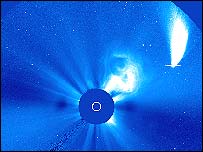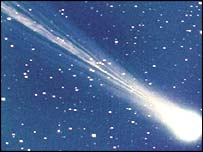Comet returns after 37,000 years
BBC News - 19 Febrero 2003
|
The comet (right)
approaches the Sun.
This spectacular image was spotted on Tuesday by a spacecraft, the Solar and Heliospheric Observatory (Soho). The joint European Space Agency/Nasa satellite is designed to give warnings of stormy space weather that might affect the Earth. Soho has photographed hundreds of comets around the Sun but this one, known as Neat, has only just been seen. |
|
|
|
It has been hovering in the evening sky for the past few weeks but is hardly visible without a telescope.
Ancient visitor: The comet, which goes by the official name C/2002 V1, is new to astronomers. The comet is putting on a spectacular show. Calculations show it has passed through the inner Solar System once before but this was 37,000 years ago. The comet is unusual in that it is very large and very bright. In fact, it is the brightest comet ever observed by one of Soho's instruments. Scientists are studying its interaction with the solar wind - the hot, charged particles flowing from the Sun. |
They hope it could reveal new information about what comets are made of. Dr Andrew Coates of the Mullard Space Science Laboratory at University College London said: "It may help us to understand better the effect that space weather has on comet tails, and such events let us measure the speed of the solar wind near a comet without sending a spacecraft there."

